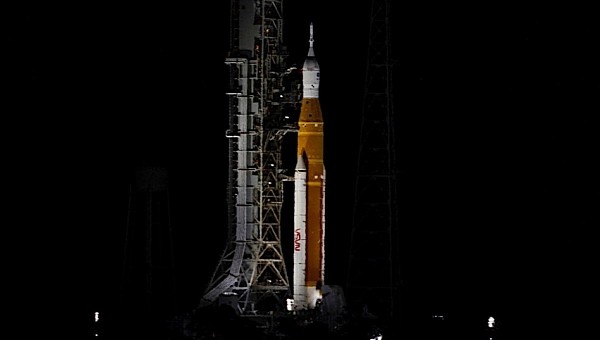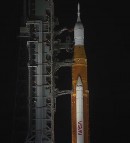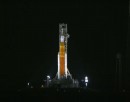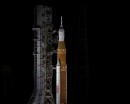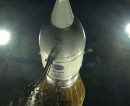As NASA continues to analyze the performance of the first SLS launch, we get a hint of how things went from following an initial data assessment. According to the space agency, the rocket either met or exceeded performance expectations.
But before getting into the specifics, let’s talk about what that statement means. As is the case with any highly complex piece of machinery in the modern era, any real-world test is preceded by many virtual simulations.
But that can only provide a limited amount of data, as it can not perfectly account for any issues that might appear. As the rocket launches and ascends into space, factors like extreme temperatures and forces can have an impact on the operation.
On top of that, such a launch system goes through dynamic phases. Before it can be relied on to take humans into space, everything must be properly analyzed to ensure it works within very strict parameters and without issues.
As such, four terabytes of data and onboard imagery from the Artemis I launch were gathered during the procedure. This was done by the SLS Engineering and Support Center at NASA’s Marshall Space Flight Center in Huntsville, Alabama.
A whopping 31 terabytes of additional imagery data was also collected by cameras positioned either on the ground, in the air, or on the rocket itself, which were following the launch. To put that into perspective, a two-hour-long 4K movie only takes up about 30 gigabytes of space. This means that the equivalent of over 1,000 4K movies worth of imagery was captured for analysis.
And the preliminary information resulting from that data is highly encouraging. The RS-25 engines, which propel the SLS, behaved within their key parameters. The thrust and mixture ratio control valves worked with a maximum deviation of 0.5% of the predicted values, while the engine internal pressures and temperatures remained within 2% of the pre-flight projection.
Moving to the in-flight performance, the SLS core stage worked as expected and inserted the ICPS and Orion spacecraft into an initial Earth orbit of 972.1 miles by 16 miles. This is a staggering achievement, as the deviation was just 2.9 miles from what NASA referred to as a “perfect bullseye” target of 975 miles by 16 miles.
The Orion then successfully separated from the ICPS after a near-perfect trans-lunar injection burn and began its 25.5-day mission. This is a great first step, critical toward building confidence in the rocket to eventually send humanity back to the Moon.
According to John Blevins, SLS chief engineer, “The SLS team will use what we learn from this flight test to improve future flights of the rocket, and we are already taking what we’ve learned about operations and assembly and applying it to streamline future missions.”
While there is still a way to go before NASA lands the first woman and the first person of color on the lunar surface, through the Artemis mission, this test proves we’re on the right track. With the success of Artemis I, we are closing in on a crewed flight for Artemis II and getting astronauts to Mars in the long run.
But that can only provide a limited amount of data, as it can not perfectly account for any issues that might appear. As the rocket launches and ascends into space, factors like extreme temperatures and forces can have an impact on the operation.
On top of that, such a launch system goes through dynamic phases. Before it can be relied on to take humans into space, everything must be properly analyzed to ensure it works within very strict parameters and without issues.
As such, four terabytes of data and onboard imagery from the Artemis I launch were gathered during the procedure. This was done by the SLS Engineering and Support Center at NASA’s Marshall Space Flight Center in Huntsville, Alabama.
A whopping 31 terabytes of additional imagery data was also collected by cameras positioned either on the ground, in the air, or on the rocket itself, which were following the launch. To put that into perspective, a two-hour-long 4K movie only takes up about 30 gigabytes of space. This means that the equivalent of over 1,000 4K movies worth of imagery was captured for analysis.
And the preliminary information resulting from that data is highly encouraging. The RS-25 engines, which propel the SLS, behaved within their key parameters. The thrust and mixture ratio control valves worked with a maximum deviation of 0.5% of the predicted values, while the engine internal pressures and temperatures remained within 2% of the pre-flight projection.
Moving to the in-flight performance, the SLS core stage worked as expected and inserted the ICPS and Orion spacecraft into an initial Earth orbit of 972.1 miles by 16 miles. This is a staggering achievement, as the deviation was just 2.9 miles from what NASA referred to as a “perfect bullseye” target of 975 miles by 16 miles.
The Orion then successfully separated from the ICPS after a near-perfect trans-lunar injection burn and began its 25.5-day mission. This is a great first step, critical toward building confidence in the rocket to eventually send humanity back to the Moon.
According to John Blevins, SLS chief engineer, “The SLS team will use what we learn from this flight test to improve future flights of the rocket, and we are already taking what we’ve learned about operations and assembly and applying it to streamline future missions.”
While there is still a way to go before NASA lands the first woman and the first person of color on the lunar surface, through the Artemis mission, this test proves we’re on the right track. With the success of Artemis I, we are closing in on a crewed flight for Artemis II and getting astronauts to Mars in the long run.
Following an initial assessment and review that determined the SLS rocket met or exceeded all performance expectations during the #Artemis I launch, @NASA engineers are taking a closer look at the data to prepare for @NASAArtemis II and beyond >> https://t.co/z4vA7nD6dH pic.twitter.com/LLBA4Q3PKw
— NASA_SLS (@NASA_SLS) January 27, 2023
